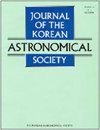蛇的传质和光时效应研究
IF 0.8
4区 物理与天体物理
Q3 ASTRONOMY & ASTROPHYSICS
引用次数: 2
摘要
用(O?C)方法研究了wuma对双星AU Ser的轨道周期变化。我们得出结论,周期变化是由于质量从主星转移到副星的速率非常低且不断减小dP/dt = ?8.872× 10 ?8,叠加了周期为42.87±3.16年的第三颗天体的正弦变化,轨道偏心率e = 0.52±0.12,经度为近天星通过!= 133°7±15。通过对地磁活动的研究,我们得出结论,Applegate机制不能描述(O ?C) AU Ser图。本文章由计算机程序翻译,如有差异,请以英文原文为准。
MASS TRANSFER AND LIGHT TIME EFFECT STUDIES FOR AU SERPENTIS
The orbital period changes of theWUMa eclipsing binary AU Ser are studied using the (O?C) method. We conclude that the period variation is due to mass transfer from the primary star to the secondary one at a very low and decreasing rate dP/dt = ?8.872× 10 ?8 , superimposed on the sinusoidal variation due to a third body orbiting the binary with period 42.87 ± 3.16 years, orbital eccentricity e = 0.52±0.12 and a longitude of periastron passage ! = 133°.7±15. On studying the magnetic activity, we have concluded that the Applegate mechanism failed to describe the cycling variation of the (O ? C) diagram of AU Ser.
求助全文
通过发布文献求助,成功后即可免费获取论文全文。
去求助
来源期刊

Journal of the Korean Astronomical Society
地学天文-天文与天体物理
CiteScore
1.30
自引率
10.00%
发文量
0
审稿时长
>12 weeks
期刊介绍:
JKAS is an international scientific journal publishing papers in all fields of astronomy and astrophysics. All manuscripts are subject to the scrutiny of referees. Manuscripts submitted to JKAS must comply with the ethics policy of JKAS. Six regular issues are published each year on February 28, April 30, June 30, August 31, October 31, and December 31. One year''s issues compose one volume.
 求助内容:
求助内容: 应助结果提醒方式:
应助结果提醒方式:


